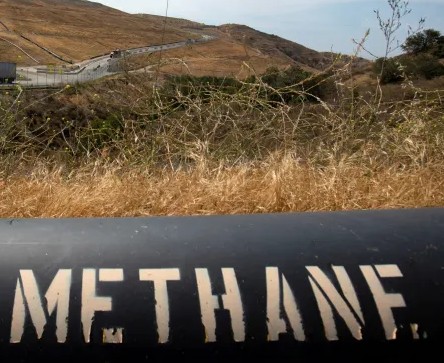There is no doubt that methane (CH4) packs a greenhouse gas punch greater than carbon dioxide (CO2) over the short term making it the low-hanging fruit of climate solutions. Maybe, that’s why talk about CH4 came up often at the recently concluded COP28 in Dubai.
But what is missing when describing CH4’s atmospheric impact is its short duration lasting a mere 12 years, and certainly no more than 20. CH4 after becomes CO2 and water vapour. So we still have two potent greenhouse gasses to deal with after the fact.
A quick comparison with CO2 shows that its impact is far greater lasting between 300 and 1,000 years. CO2 only leaves the atmosphere when it is absorbed by oceans, plants, soil, and the weathering of rocks. The latter occurs when CO2 combined with water falls as precipitation on basalt which turns into calcium carbonate, better known as limestone.
Greenhouse Gas Facts
CH4 and CO2 aren’t the only greenhouse gasses. What follows gives you some pertinent facts:
- A kilogram of CH4 is expressed as equivalent to 29.8 kilograms of CO2 in terms of its molecular heat-trapping potential.
- Nitrous oxide (N2O) another potent greenhouse gas is equivalent to 298 kilograms of CO2 in comparison.
- Hydrofluorocarbons (HFCs), Perfluorocarbons (PFCs), Sulphur hexafluoride (SF6), and Nitrogen trifluoride (NF3) used in industry and refrigerants today represent much smaller volumes but over 20 years have a warming potential that ranges from 460 to 16,300 times greater than CO2.
- Water vapour is the most potent greenhouse gas but human activity plays no direct part in Earth’s water cycle. When discussing anthropogenic climate change, therefore, the impact of water vapour on atmospheric warming is not factored in.
- Compared to all of the above, CO2 has the lowest atmospheric warming potential. But it makes up for the low potential in volume and by the length of time it lingers.
- A kilogram of CO2 entering the atmosphere today will be around for as long as a thousand years. Humans are not putting kilograms but rather megatons of CO2 into the air annually. When compared to volcanic eruptions each year, we produce 60 times more. Our total emissions for 2022 were 36.8 billion tons. That was 0.9% higher than in 2021 but lower than the rate of global economic growth at 3.2%.
The Fallacy of Focus at COP28
Why is a potency comparison between CH4 and CO2 such an issue? Because headlines from COP28 in Dubai included agreements about CH4 and got front-page coverage.
A global pledge by 155 governments and 50 oil and gas companies to reduce CH4 from oil and gas, waste, and agricultural activities was featured in press conferences and the final communiqué. It contained a CH4 reduction target of 30% by 2030 from 2020 levels, describing this as “the fastest way to reduce near-term warming” and “to keep a 1.5 Celsius temperature limit within reach.”
CH4 was described as contributing 30% of current global warming and was further seen as a contributor to tropospheric ozone (aka ground-level ozone), the latter described as being the cause of hundreds of thousands of deaths and millions of tons in crop losses annually.
The communiqué went further, stating that a rapid reduction in CH4 emissions would mitigate near-term global warming and contribute to better health, food security, and energy security for humanity and the planet.
CH4 Balderdash Revealed
CH4 emissions are the least of our greenhouse gas worries. The amount of warming caused by CH4 is short-term because it doesn’t accumulate in the atmosphere for 12 to 20 years. Then it degrades to become a CO2 problem. Delay CH4 action and its effect vanishes in two decades. Delay acting on CO2, and it keeps accumulating for up to 1,000 years. That’s why every added kilogram of CO2 is the much greater global warming threat.
If you don’t believe me, Raymond Pierrehumbert, a physicist and professor at the University of Oxford, in a recent interview appearing in the Bulletin of the Atomic Scientists makes the same point. He states,
“Whereas a kilogram per year of CO2 will mount up to a certain amount of warming in the first 20 years…if you keep emitting that kilogram per year, the amount of warming you get continues to increase indefinitely, which does not happen with CH4.”
Pierrehumbert compares the two gasses for their global warming impact using the analogy of a car trip.
“CO2 is like the total distance your car has gone, so it’s the cumulative progress towards your destination, and our destination, in this case, is making the world too hot to be livable. Whereas CH4 is just like the speed at which the car is going…a stock versus flow problem…CH4 is a flow pollutant; it doesn’t accumulate in the atmosphere. CO2 is a stock pollutant. The harm is determined by the cumulative stock of it in the atmosphere.”
Regarding COP28, Pierrehumbert concludes that the fixation with CH4 is a “seduction” a “mass delusion and wishful thinking.” The focus on CH4 reduction will not contribute significantly to mitigating climate change when “compared to how much warming we’re going to get in 100 years if we don’t decarbonize.”
















